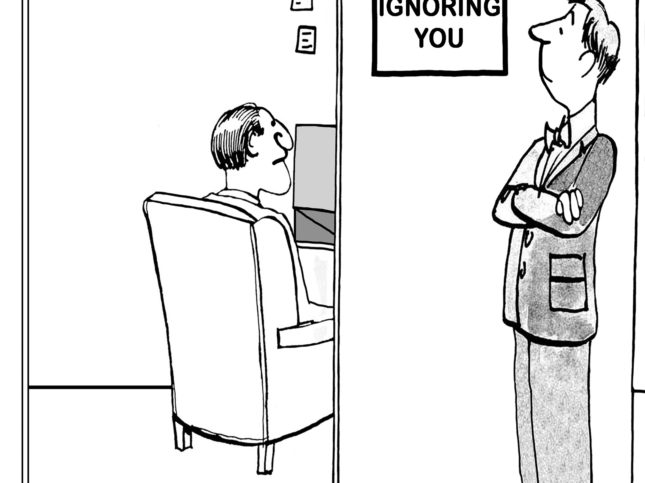Pain or Gain: Your Sales Approach Matters
As we saw in our last post, people differ in their approach to motivation: some are more focused on prevention goals and strategies (moving away from pain), and others on promotion goals and strategies (moving towards gain). When you adapt your sales approach to fit theirs, they will be more engaged, understand your message easier, and feel better about their decision. And the best part is that once you learn how to do it, it’s not that difficult to do.
First step: Figure out their dominant mode
Since it’s so important to properly align your sales approach to the other person’s prevention or promotion focus, you have to be able to quickly size them up and figure out which approach to use. Fortunately, there are numerous clues you can glean from what they talk about, the words they use, and even their nonverbal behavior.
What are their goals? Ask them what they want to accomplish and what success will look like when they make this decision. Promoters are going to talk about taking advantage of opportunities, of their aspirations and hopes for the future, and what they want to achieve. Preventers will talk about known problems and risks, about what they’re concerned about, about what they must avoid or prevent. You can also accomplish the same thing by asking them how they made similar decisions in the past.
What alternatives are they considering? Promoters like to look at a lot of alternatives, and are open to new and different ways of doing things. Preventers are more limited, and more conventional. Also, promoters want the best, preventers want “good enough”.
What is their time horizon? Promoters move quickly and eagerly. Preventers prefer to take their time and don’t like quick deadlines.
“I” vs. “We” goals. Promoters are more concerned with individual achievement and looking good. Preventers focus on group achievement.
How prepared and organized are they? Promoters say “let’s do it”, preventers say “let’s plan it”.
Attention to detail. Promoters are more big picture and abstract. Preventers pay attention to detail and like to consider concrete features and benefits.
Promoters move quickly and get excited when they consider success. Preventers are slower and more guarded.
Just one more caveat before proceeding: Don’t forget to assess yourself, because you are probably relying on one approach regardless of who you’re selling to. You probably know yourself well enough, but just in case, here’s a questionnaire you can use.
Second step: Tailor your approach
There are three general ways you can apply prevention-promotion focus in your sales approach: you can adapt to their mode, prime them to adapt to yours, or hedge your bets by using both approaches.
- Adapt your approach to suit their dominant focus.
Frame their benefits appropriately. Sales is basically about one thing: you address gaps to improve outcomes. So, the frame choice is quite simple: do you talk more about eliminating or preventing a gap, or about the outcome produced by doing so? The exact same benefit can be expressed in different ways. For example, a client of mine sells sentiment analysis software that can be used to monitor morale, which either cuts turnover or improves retention. Another example: are you lowering fuel costs, or improving fuel efficiency?
Choose which benefits to stress. Most products and services deliver multiple benefits, so you can prioritize some over others. For example, toothpaste can either give you a brighter smile or prevent tooth decay.
Emphasize some questions over others. Challenge and cost questions bring out consequences of not fixing their current situation. You can ask more of those during your sales call with a preventer; ask more resolution questions of a promoter.
Tell different stories. Inspirational tales and testimonials about your other customers who received benefit from your solutions work well with promoters, but cautionary tales about those who did not solve their problems will resonate more with preventers.
Options. Give more options to promoters; limit them for preventers.
New vs. same. When you’re summarizing your offer, emphasize what’s new and different for promoters, but stress what’s tried and true—what’s not different—for preventers.
Abstract v. concrete. For promoters, emphasize the abstract feel-good outcomes, and paint a visionary picture of what success looks like; for preventers, emphasize concrete, measurable features and outcomes. You can also vary how you present competing alternatives. Promoters like to hear all about one offer, then the next. Preventers prefer to see their specific features and benefits rated side by side.
Nonverbal behavior. Without going overboard, it helps to match the general tenor of the other person’s body language. Use more expansive and animated gestures and vocal variety with promoters; tone them down for preventers.
- Prime their focus temporarily
Some products or services can only be framed in one way; they are either promotion or prevention focused by their nature. You don’t sell a Porsche by stressing safety and fuel economy, nor do you sell a Volvo by touting its sexy lines. If what you sell only makes sense to be sold one way, the good news is that you can actually “prime” the other person to adopt a prevention or promotion focus, at least for a short time by bringing to mind the appropriate examples.
One of the best ways is through asking the right kind of situation questions. If you ask about what’s important to them personally, you can either ask about their ambitions and aspirations, or you can ask about their duties and obligations. When you ask about what they want to accomplish, you can either ask about what they’re trying to achieve or improve, or you can ask about what problems and risks they’re concerned about. The old “magic wand” question works great to prime a promotion focus: “If you had magic wand and could design the perfect solution, what would it look like?” To get them into a prevention frame of mind, ask them, “On a scale of 1-10, how well is the current system working for you?”
- Use both approaches – the “persuasive scissors” approach
If you’re speaking to a roomful of people, chances are good that you will have a mixture. Make sure your presentation or conversation covers both approaches. I call this the persuasive scissors approach, because both blades work together towards the same end. Many persuasive presentation structures are well designed for this. For example, the problem/solution structure begins by describing the problem and quantifying its consequences, and ends with a description of the benefits to be gained by solving it. Even Martin Luther King’s Dream speech was structured this way.
BONUS SECTION: MOTIVATING AND COACHING SALES REPS
I believe that motivating sales reps is a lot like selling: you analyze the situation, ask a lot of questions, uncover gaps, and then get buy-in for a plan to fill them. So, much of what you’ve read in this article can help you with your reps as well.
The importance of regulatory fit means that you shouldn’t coach all your subordinates the same way.[1] If you doubt the hold that one’s pre-pro focus can have, consider the results of an experiment involving professional soccer players in Germany. After being tested to determine their focus, they were given the opportunity to shoot five penalty shots during one of their practices. Some were told their task aspiration was to score at least three times. Others were told their obligation was not to miss more than twice. Even these professionals saw a 30% difference in their performance, depending on whether their instructions fit with their prevention or promotion orientation. It was especially marked for prevention-focused players, who saw almost a 100% difference[2]. As a sales manager, it should not take too much imagination to figure out how to apply this to coaching your reps.
When you give performance reviews, or conduct after-action reviews promoters respond better to hearing what’s going well, but preventers do better upon hearing what they’re falling short on. By the same token, pep talks work well for promoters but leave preventers cold.[3]
[1] It reminds me of what John Wooden said: “Fairness is giving all people the treatment they earn and deserve. It doesn’t mean treating everyone alike.”
[2] This statistic was reported in Focus: Using Different Ways of Seeing the World for Success and Influence, by Heidi Grant Halvorson, which is the best book for a general audience. I highly recommend it, especially since it contains a lot of other useful ways to apply focus to your own goals and motivations.
[3] There is some good stuff in this article by Halvorsen and Higgins in Harvard Business Review: Do You Play to Win—Or Not to Lose?




